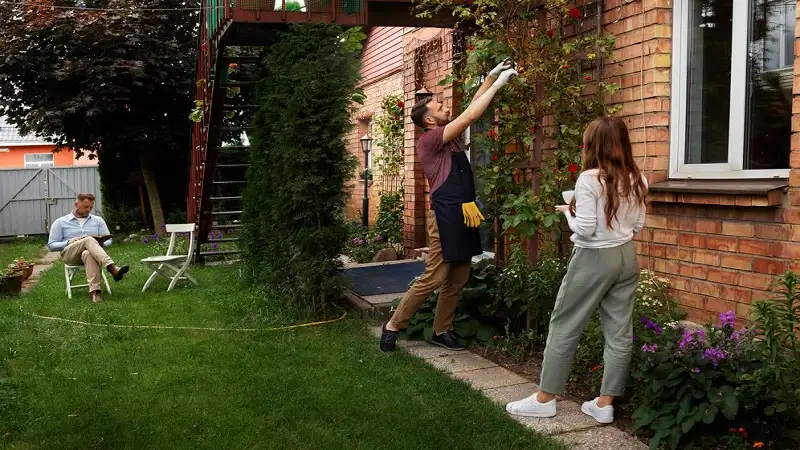It’s easy to spend time and money making your home’s interior look just right — but the exterior? That’s where first impressions happen. And the truth is, small tweaks to your outdoor design can make a huge impact, whether you’re hoping to impress guests, attract buyers, or simply take more pride in your space.
The best part? You don’t need a full landscaping overhaul to make your home stand out for the right reasons. Often, it’s thoughtful material choices and a few creative touches that deliver the biggest return. For example, swapping out a plain concrete walkway for cobblestone pavers adds instant texture, structure, and curb appeal — all with minimal effort and long-term benefits.
Whether you have a big yard or just a front entry to work with, these outdoor design tricks can help your home look more intentional, inviting, and well put together.
Start with the Entry — It Sets the Tone
Your front entry is the natural focal point of your home’s exterior. It’s the first thing people see and often the detail they remember most.
Quick ways to enhance the entrance:
- Add symmetry: Flank the doorway with matching planters, lighting, or decor for a balanced look.
- Paint the door: A bold or unexpected color (like deep navy or soft sage) can instantly modernize the facade.
- Update house numbers and fixtures: Sleek, easy-to-read numbers and stylish lighting make your home feel current and well cared for.
Even small updates here can shift the overall feel of your home from standard to standout.
Use Hardscaping to Add Structure
Hardscaping — things like walkways, patios, stone borders, or retaining walls — gives your yard definition. These elements organize the space and make everything feel more deliberate.
Well-designed hardscaping also adds visual weight to your yard. For example, a gravel seating area framed with natural stone feels grounded and polished, even if it’s just a small corner of the yard. The goal is to create clean lines and contrast with softer elements like plants or grass.
Tips for successful hardscaping:
- Stick to natural tones that complement your home’s exterior
- Avoid overcomplicating the layout — simple lines look neater and age better
- Use curves strategically to soften corners or guide the eye
Layer Your Landscaping
A common mistake in front yard design is planting everything in a single line. It’s practical, sure — but it doesn’t do much visually.
Instead, think in layers: low ground cover in the front, mid-height shrubs or grasses in the middle, and taller plants or small trees in the back. This adds dimension and helps lead the eye up toward your home.
For maximum impact with minimal maintenance, choose a mix of perennials and native plants suited to your climate. They’re hardier, require less water, and tend to look better year-round.
Incorporate Lighting That Works (and Looks Good)
Lighting isn’t just functional — it’s a design feature in its own right. A well-lit yard feels warm, safe, and welcoming. Plus, it allows you to enjoy your space long after the sun goes down.
Where to add outdoor lighting:
- Pathways and steps for safety
- Up-lighting around trees or architectural features
- Accent lights under eaves or along fences
Use soft, warm-toned bulbs and keep it subtle — you want your lighting to enhance the space, not overpower it.
Create a Focal Point
Just like you’d have a statement piece in a room — a fireplace, artwork, or feature wall — outdoor spaces benefit from a visual anchor.
This could be:
- A water feature or small fountain
- A fire pit with surrounding seating
- A garden sculpture or decorative urn
- A striking plant, like a Japanese maple or tall ornamental grass
A focal point draws attention and gives the rest of your yard a sense of organization. It doesn’t have to be big — just something that feels intentional and adds character.
Keep It Tidy and Consistent
No matter how beautiful your landscaping or design elements are, clutter or neglect can undo the effect. Consistency and cleanliness go a long way in helping your home stand out in a good way.
Maintenance musts:
- Keep walkways clear and free of weeds
- Trim overgrown plants and trees regularly
- Clean your windows, door frames, and porch area
- Store tools, hoses, and other items out of sight
Consistency also applies to your color palette and materials. Try to repeat the same two or three textures or tones throughout your outdoor space so everything feels unified.
Think Seasonally
A final trick? Make sure your outdoor design works year-round. That doesn’t mean planting everything to bloom in spring and fade by July. Instead, choose a mix of plants, materials, and decor that look good in all seasons.
Evergreens, ornamental grasses, and hardscape elements carry your yard through winter. Mulch and ground cover keep things tidy in between planting cycles. Even updating your porch decor seasonally — think lanterns in fall, string lights in summer — helps your home stay fresh and eye-catching.
Subtle Changes, Big Results
Great outdoor design isn’t about copying what everyone else is doing — it’s about highlighting your home’s strengths and adding thoughtful details that elevate the overall look. With just a few well-placed upgrades and a bit of creativity, your home can stand out — not because it’s flashy or overdone, but because it feels complete, cared for, and uniquely yours.
